Publications
Shaping Cultural Identities Through Photomechanical Reproduction(by Camilla Balbi, Fedora Parkmann, and Katarína Mašterová)
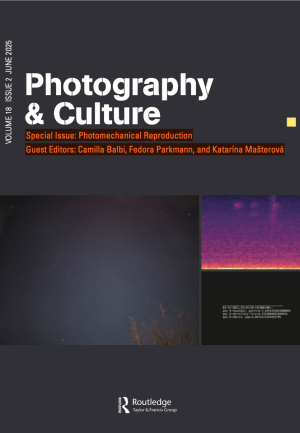
2025-12-01
#special issue
Camilla Balbi, Fedora Parkmann, Katarína Mašterová (eds.), special issue Shaping Cultural Identities Through Photomechanical Reproduction, Photography & Culture, vol. 18, no. 2, 2025.
This special issue seeks to raise awareness about photomechanical reproductions—the printed images through which most photographs have historically circulated—and argues that understanding their material nature, production processes, and social lives is essential for interpreting how photography has shaped cultural and national identities. Through diverse case studies—from Norway, Japan, and Poland to Jewish visual culture, Australian archives, postcard industries, and contemporary artistic practice—the editors and contributors of this issue call for the recognition of photomechanical reproductions as central objects of study in the historiography of photography.
Introduction
Camilla Balbi, Fedora Parkmann and Katarína Mašterová, Shaping Cultural Identities Through Photomechanical Reproduction
Research Articles
Nina Lager Vestberg, Reproducing a Nation: The Photomechanical Construction of Norway 1884–1905
Karen M. Fraser, Constructing Knowledge Between East and West: The Photographic Books of Ogawa Kazumasa
Dorota Łuczak, The Art Book Wit Stwosz. Ołtarz Krakowski (1951) in the Snares of Ideology: Art Reproduction Between Agency and Appropriation
Marta Ziętkiewicz, Discussing Shared Heritage: Politics of Photomechanically Illustrated Publications on Synagogues in Poland (1895–1957)
Archive
Jane E. Brown, The ‘Museum of Photographs’: Photomechanical Reproductions of Artworks in the Conway Collection, University of Melbourne
One Photograph
Portfolio
Benjamin Levy, From Pixel to Grain: Pressure and Touch in Rafael Soldi’s CARGAMONTÓN
Erwin Panofsky and Modernity. Painting Photography Film(by Camilla Balbi)
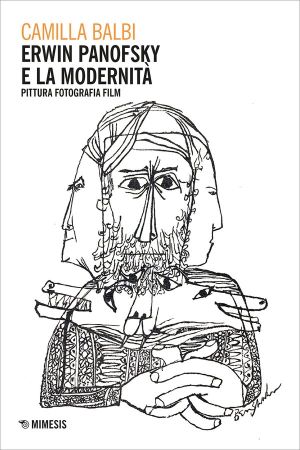
2025-02-20
#book, in Italian
Erwin Panofsky's legacy is characterized by profound contradictions. As the undisputed father of art history of the last century, Panofsky has repeatedly been portrayed as a symbol of the ‘scholar in the ivory tower’, of the supremacy of content over form, and of an art history that refuses to engage in dialog with the artistic and cultural changes of the twentieth century. This study challenges this consolidated historiographical portrait. Indeed, the book outlines critical perspectives that trace Panofsky's interest in the art of his time, in cinema and in photography. The result is a complex portrait in which the achievements of the 20th century are reconsidered in the light of the humanist tradition and the classical is traversed by the contemporary in surprising ways, leading to interpretations that not only challenge the traditional reception of the author's work, but also question the hegemony of modernism in the treatment of 20th century art and media.
Camilla Balbi, Erwin Panofsky e la modernità. Pittura fotografia film, Milano: Mimesis, 2025. 354 pp.
ISBN: 9791222318028
Satire and Revolution. Political Photomontage Seen from Central Europe(by Fedora Parkmann)

2025
#book chapter
Following the relocation of John Heartfield and the magazine AIZ to Prague in March 1933, Central Europe, with Czechoslovakia at its center, emerged as one of the hotbeds of political photomontage. Since the 1920s, the avant-garde group Devětsil had promoted photomontage not only as a medium of artistic expression for the production of “picture poems” but also as a tool of political agitation in posters, book covers, and press illustrations. The Association for Revolutionary Culture Levá fronta and its film-foto group founded in 1931 continued this trajectory, publishing numerous photomontages in the leftist press. This essay examines how the local tradition of political caricature, Heartfield’s arrival and the presentation of his photomontages in Prague, together with the circulation of Soviet works in exhibitions and publications converged to make Czechoslovakia a platform for the dissemination and experimentation of the latest trends in political communication – at the crossroads of satire and agitprop.
Fedora Parkmann, “Satire et révolution. Le photomontage politique vu depuis l’Europe centrale”, in Max Bonhomme & Aline Théret (eds.), Couper, coller, imprimer. Le photomontage politique au XXe siècle, exh. cat., Paris: Anamosa / La Contemporaine, 2025, pp. 103–108.
Lost in the series. The Central European photographic avant-garde and the strange case of the Röntgenbild einer Scholle(by Camilla Balbi)
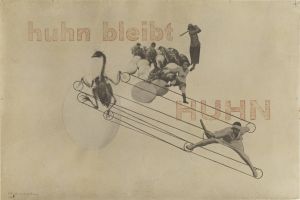
2025
#academic journal paper, in Italian
Recent contributions in the field of periodical studies broadly agree in identifying seriality as the main “defining feature”(Levay, 2018) of illustrated magazines. The serial development of what can be regarded as the first “visual mass medium”(Fröhlich, 2022) would, in other words, constitute their principal characteristic, fundamentally shaping their visual and temporal unfolding. However, seriality in periodicals has generally been analysed only from a narrative-discursive perspective, with little attention paid to its visual, material, and media-related dimensions. The proposed paper instead examines the interdependence between visual seriality, transnational networks, and photomechanical reproduction techniques in the 1920s, highlighting the fruitfulness of such an approach for periodical studies, visual studies, and art history. More specifically, it retraces the complex history of photomechanical reproduction and remediation that, between 1925 and 1931, characterised the trajectory of a single, specific X-ray photograph. Produced at the Lette Verein in Berlin—most likely by a female student (the Lette Verein was a technical school for women, founded to support their entry into the workforce)—this image circulated seamlessly between scientific research and avant-garde aesthetics: it was reproduced in medical publications in Vienna and in art magazines in Berlin, before appearing in 1928 in the Prague avant-garde journal ReD, directed by Karel Teige, and was eventually—erroneously—incorporated in the early 1930s into the corpus of Moholy-Nagy, where it has remained ever since.
Analysing not so much, or not only, the original image but rather its Nachleben as a photomechanical reproduction makes it possible to release it from the hermeneutic isolation that often characterises the study of avant-garde photography, redirecting attention to the serial context (one might speak of “serialization across periodicals”—Hammill and McGregor, 2018) of its reception, mediation, and afterlife.This unpublished case study also aims to show how a different approach—one attentive to the seriality, mediality, and materiality of early twentieth-century print culture—can enrich our understanding of the relationship between scientific images and art history. By reconstructing the migration of an image, it becomes possible to spark new insights and even arrive at new attributions, shedding light on subjectivities, histories, and forms of authorship traditionally overlooked by the modernist canon.
Camilla Balbi, “Lost in the serie. L’avanguardia fotografica mitteleuropea e lo strano caso della Röntgenbild einer Scholle” [Lost in the series. The Central European photographic avant-garde and the strange case of the Röntgenbild einer Scholle], Fata Morgana, XVII, 54, 2025, pp. 121-139.
Art history malgré tout. Rachel Wischnitzer and the medial premises for a Jewish art history in Berlin (1922-1933)(by Camilla Balbi)
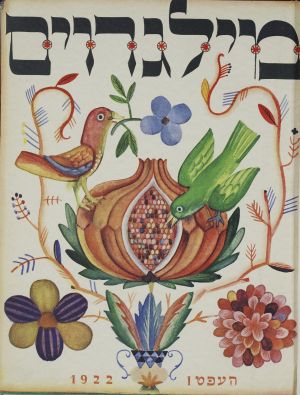
i
Cover of Milgroym, 1922.
2025-02-19
#academic journal paper, in Italian
From 1921 to 1924, Berlin became one of the epicenters of the so-called “Weimar Jewish Renaissance”: a golden age of cultural, artistic, and literary activities that for the first time sought to address a specifically Jewish audience and create a Jewish public sphere. Flooded with refugee Jewish intellectuals from Eastern Europe, the city became an ideal platform for the rise of Jewish books, whose publication and dissemination was facilitated by low-cost printing and postage during the years of hyperinflation. Printed in Germany, these books and magazines were exported around the world. For intellectuals interested in art history, this was the first opportunity to present a significant amount of Jewish visual material to the public. The material, often locked away in archives or located in remote regions of the Middle East or Eastern Europe, had previously received little attention as an object of study. The most significant attempt to include it in the Western art-historical and theoretical debate was made by Rachel Wischnitzer, a Russian-born art historian, in her bilingual (Hebrew and Yiddish) magazines Rimon/Milgroym, published in Berlin between 1922 and 1924. These magazines are considered “the most beautiful and interesting journals of Jewish art that ever appeared”. In the paper, I will reconstruct the material history of the magazines using archival material from the Leo Baeck Institute. This involves investigating the production, reception, and afterlife of the photomechanical reproductions they contain. The reproductions resulted from a complex interaction of academic scholarship and avant-garde research (noteworthy is El Lissitzky’s engagement in producing some of the pictures of the Mogilev Synagogue) which played a role in preserving what was, in some cases, the only visual evidence of artworks that perished in the war, thus bringing to light the construction of the first Jewish transnational visual culture.
Camilla Balbi, Storia dell’arte malgré tout. Rachel Wischnitzer e le premesse mediali per una storia dell’arte ebraica a Berlino (1922-1933), Cultura Tedesca 68, July-December 2024, pp. 269–294.
Seated Girl: Art in the Home(by Hana Buddeus and Mariana Kubištová)
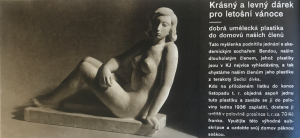
2024-11-26
#chapter in an edited volume, in Czech
The case study examines a terracotta sculpture titled Seated Girl, introduced in 1935 by Krásná jizba of Družstevní práce. It also delves into its promotion through photographs by Josef Sudek. Created by Břetislav Benda, the statuette raises questions about how art is received in different contexts—specifically, the intimacy of the home versus the public space of an art museum or gallery. The sculpture’s design aimed to appeal to a broad audience of potential buyers while maintaining the standards of high-quality art. In Seated Girl, a tension emerges between the period’s ideals of "art for everyone" and the aesthetic aspirations of modern art.
Hana Buddeus – Mariana Kubištová, "Sedící dívka. Umění v bytě", in: Kateřina Piorecká - Marie Brunová - Lukáš Holeček - Martin Lukáš (eds.), Gesto a skutečnost. Umění v meziválečném Československu, vol. 1. Obyčejný život [Gesture and Reality. Art in Interwar Czechoslovakia. vol. 1. Ordinary Life], Praha: Academia 2024, pp. 423-432.
Saint Vitus / Saint Guy: Fifteen Photographs / Quinze Photographies. Exclusive Photo Album for the Cost of Production (by Katarína Mašterová)
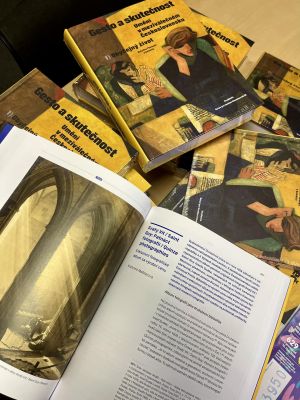
2024-11-26
#chapter in an edited volume, in Czech
In 1928, the jubilee year marking the establishment of the Czechoslovak Republic, the publishing house Družstevní práce (Cooperative Work) planned to release a special album dedicated to the Cathedral of St. Vitus in Prague. At that time, the cathedral was undergoing extensive completion work and was set to be opened to the public in 1929, coinciding with the millennium of St. Wenceslas's martyrdom. Although relations between the state and the Catholic Church were strained at the time, the cathedral became a national symbol. The album included fifteen original bromo-silver photographs by Josef Sudek. He was recommended to the director of the publishing house, Václav Poláček, by painter Emanuel Frinta, who also created the album's graphic design. The celebratory, poetic foreword was penned by the Catholic author Jaroslav Durych. Sudek, an emerging professional photographer at the time, compiled the album from his photographs of the cathedral which he had been taking "for himself" from 1924 onwards. These images not only reflect his professional approach and genuine fascination but also showcase his delicate artistic style and contemporary interest in genre scenes. Anna Fárová described the album as "majestic and grandiose, a truly spiritual and patriotic collection." Despite Durych's acclaimed poetic introduction, it is the photographs themselves that have emerged as a modern tool for promoting this traditional religious monument, appropriated by the nation. The album was published as a limited collector's edition, with only 120 copies printed. However, it reached a much wider audience because individual photographs were displayed in the Cooperative Work’s booth at the Exhibition of Contemporary Culture in Brno and published in contemporary magazines such as Světozor and the Sunday supplement to Prager Presse.
Kataría Mašterová, "Svatý Vít / Saint Guy: Patnáct fotografií / Quinze photographies. Exkluzivní fotografické album za výrobní cenu", in: Kateřina Piorecká - Marie Brunová - Lukáš Holeček - Martin Lukáš (eds.), Gesto a skutečnost. Umění v meziválečném Československu, vol. 1. Obyčejný život [Gesture and Reality. Art in Interwar Czechoslovakia. vol. 1. Ordinary Life], Praha: Academia 2024, pp. 208–222.
Lothar Brieger’s Das Frauengesicht der Gegenwart (1930): A Twofold Perspective on Women’s Photography in the Weimar Republic(by Camilla Balbi)

i
Cami Stone, Schauspielerinnen Geschwister Stobrowa, 1930
2024-06-19
#academic journal paper
Historians have now commonly acknowledged how the photographic atlas, in its many forms – perhaps the most celebrated being Aby Warbug’s Atlas Mnemosyne – had been employed in Germany during the years of the Weimar Republic as an extraordinary epistemological device to conduct historical, political, psychological and more broadly culturological investigations. And yet, some declinations of the device-atlas still remain singularly unstudied. This is the case with Das Frauengesicht der Gegenwart (The Face of the Women of the Present), the subject of the proposed contribution. Published in 1930 by the art historian Lothar Brieger, shortly before racial laws forced him to leave Germany, this photographic book (71 pages out of 135 are photographic plates) was realized with the aim of celebrating female self-affirmation against the conservative tendencies that were beginning to spread in the ascendant National Socialist society, constituting perhaps the most intense, and the last, representation of the Neue Frau in the German context. In the article, a dual perspective will be adopted. On the one hand, Brieger’s thought will be analyzed in dialogue with the main theories of art and photography of his time. On the other hand, the photographs in the book themselves will also be considered separately from their theoretical framework, investigating their photomechanical lives, and the view of the “modern woman” proposed by their, long forgotten, material authors.
Camilla Balbi, Lothar Brieger’s Das Frauengesicht der Gegenwart (1930): A Twofold Perspective on Women’s Photography in the Weimar Republic, Piano B. Arti et culture visive, vol. 8, no. 1, 2023, Storia, teoria e pratiche femministe nell’arte del XX secolo, edited by Cristina Casero and Raffaella Perna, pp. 1–23.
URL: https://pianob.unibo.it/article/view/19506/17892, https://pianob.unibo.it/issue/view/1272
The (Theoretical) Elephant in the Room. Overlooked Assumptions in Computer Vision Analysis of Art Images(by Camilla Balbi and Anna Calise)
2023-11-06
#academic journal paper
Contemporary computer vision software represents an incredible opportunity for both art history researchers and museum practitioners: it is a tool through which images can be described, organized, studied and shared. In this process—the one in which a computer vision software operates over a database of art history images—there are however a variety of dynamics at play. They have to do with theoretical assumptions, historical categories, technological constraints and ideological stances: a set of premises which calls for a closer methodological survey of the process. We propose an account which uses art theory and visual culture studies to scrutinize the different steps and activities which constitute the computer vision analysis: after all, the study of images has historically been a prerogative of art historians. Our intuition is that art images databases somehow provide a “protected environment” in which to observe how old problems, inherent to the discipline, interact with new problems created by the way we consume and design software. The three levels at which we will try to detect biased stances answer three different questions. Which images are we talking about? Which research questions are we asking? Which linguistic and political logics are at play? In order to do so, we will begin the discussion by debunking the myth of a simple parallelism between these new forms of conceptualizing the real and traditional ones, challenging Manovich’s (1999) use of Panofsky’s symbolic form (1927) as a hermeneutic of the database. We will show instead how the art-database logic somehow sticks to the traditional art historical narrative, while at the same time producing new kinds of biases. Then, we will focus on how this technology actually works, and which kind of art historical thought lays behind the algorithm. Our guess is that the praxis of this software is closer to the connoisseurship than to the art historical research. Thirdly, we will analyze the labeling process through which computer vision software creates descriptive metadata of the images in question, using Mitchell’s critical iconology (1994) account to problematize the strong ideological and political stance behind the image-text relationship. Throughout the discourse, and especially in the final paragraph, we will address the transparency and evaluation standards which need to be defined in order to allow a strict methodological approach to guard and guide the process, at times lacking both in the cultural sector and in the wider visual field. What will emerge is an account of computer vision software and processes which appear to be far from ‘neutral’ or ‘objective’ in their extremely layered functioning, built in the midst of diverse stakeholders’ interests and procedural false steps. Granted that these technologies are however contributing to build the visual culture of our time, we detect a series of overlooked assumptions along the way through the lenses of art theory, hoping to contribute to the design of a clearer view.
Keywords: artificial intelligence, digital archives, image, art, ideology
Camilla Balbi and Anna Calise, The (theoretical) Elephant in the Room. Overlooked Assumptions in Computer Vision Analysis of Art Images, Signata [En ligne], 14 | 2023.
URL : http://journals.openedition.org/signata/4757
DOI : https://doi.org/10.4000/signata.4757
La Tour Eiffel, ou l’histoire d’un cliché: une image-fétiche de l’avant-garde entre France et Tchécoslovaquie(by Fedora Parkmann)
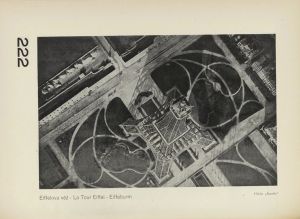
i
Anonymous [Karel Teige], “Eiffelka, čili historie jednoho klišé” [The Eiffel tower, history of a printing-block], ReD, vol. 2, No. 7, March 1929, p. 222. © National Gallery Prague 2022.
2023-05-01
#book chapter, in French
The Eiffel Tower, History of a Printing-Block: An Avant-garde’s Favourite Between France and Czechoslovakia
This book chapter traces the successive appearances of an aerial view of the Eiffel Tower in French and Czech publications between 1909 and 1928. The image proved particularly inspiring to the avant-garde as it switched contexts from Karel Teige and Le Corbusier’s publications to the paintings of Robert Delaunay. By pointing out the changes in formal adjustment and meaning that the image underwent, this case study provides a measure of the circulation of photo-reproductions within avant-garde networks and their repercussions in artistic work.
Keywords: Eiffel Tower, photography, Karel Teige, Le Corbusier, Robert Delaunay, photographic reproduction
Fedora Parkmann, "La Tour Eiffel, ou l’histoire d’un cliché : une image-fétiche de l’avant-garde entre France et Tchécoslovaquie", in Léa Saint-Raymond (ed.), La circulation des images en Europe, Paris: Mare & Martin, 2023, pp. 189–202, ISBN 978-2-36222-085-2.
Dis/placed Modernism: Ellen Auerbach and Marianne Breslauer’s Palestine(by Camilla Balbi)
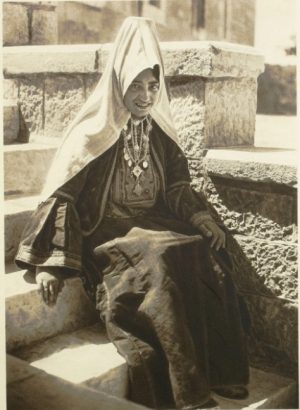
i
K. Gröber, Married woman from Bethlehem, 1925. Gravure printing photograph. In ID., Palästina, Arabien und Syrien: Baukunst, Landschaft und Volksleben, p. 112. Copyright expired.
2023-08-26
#academic journal paper
This paper addresses geographical displacement, elsewhereness, as a fundamental experience in early twentieth-century culture. It examines its aesthetic and epistemological consequences in the specific context of German-Jewish women's photography created in pre-state Israel during the 1930s. The article focuses on photographs taken during the Palestine sojourns of two prominent photographers from the Weimar Republic: Marianne Breslauer and Ellen Auerbach. The two moved not only through geographical locations, but also through intersecting imaginaries, ethno-religious and gender identities on the margins of discourses and political systems: as women, as Jews, and as photographers. The article explores these balances at a delicate historical juncture: when a distant spiritual homeland slowly becomes a complex territory for very complicated immigration, and travel photography turns into exile photography. The resulting photographs exist within a dynamic interplay between ancient collective memories of the “Land of the Bible” and the modernist iconographies associated with Zionist nation-building, the enchanted gaze towards the Arab East, and a German training altered by displacement. Finally, from a theoretical perspective, the study examines how the displacement of the two photographers partially decentered their modernist background, expanding the dimensions of the modernist canon to include nomadism, memory, and longing.
Keywords: Ellen Auerbach, Marianne Breslauer, Weimar Photography, exile, Palestine
Camilla Balbi, “Shifting Paradigms — Mexico in color: Ellen Auerbach’s exile photography”, Itinera, no. 23: Colour: Photography, Image, Reality / Aesthetics, Technique and Emotion, 2022, pp. 115–130, ISSN 2039-9251.
Presentations
Scaling Photomechanical Reproductions: Images in Periodicals and Automated Data Collection(by Viktorie Vítů)
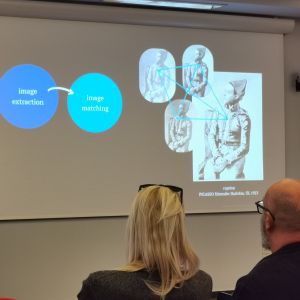
2025-10-16
#conference talk
The Photomatrix project integrates automated data extraction, image classification, and metadata enrichment to analyze photomechanical reproductions of artworks in early 20th-century periodicals. This type of source material requires an interplay between quantitative and qualitative approaches, where large-scale pattern analysis will inform (and will be informed by) archival research and historical interpretation. This presentation will examine how the layered nature of photomechanical reproductions shapes the methods we use to work with them. I will present our process of acquiring and structuring the data, and close with some preliminary findings from our research on image scale. Additionally, I will reflect on how the fact that the automated collection of visual data introduces fundamental challenges, particularly regarding the accuracy, reliability, and epistemological implications of machine-assisted methods.
At the core of Photomatrix is a relational database that structures reproductions, their captions, printing blocks, source photographs, and artworks and objects featured in the image. The automated workflow consists of multiple stages: 1. IMAGE EXTRACTION: A custom-built application detects and extracts images from digitized periodicals, pairing them with page-level metadata. 2. IMAGE MATCHING: A deep learning model identifies identical or near-identical reproductions across different issues and publications. 3. LABELLING: AI-assisted classification assigns labels based on the type of object depicted in each image. 4. CAPTION ANALYSIS: language model parse captions, extracting information such as authorship, title, and dating. 5. FINAL DATA INTEGRATION: language model will combine the results obtained in the previous steps and integrate them into the database.
While automation enables the processing of large datasets, each step in the pipeline introduces biases and uncertainties. Moreover, the distinction between reproduction, photograph, and artwork remains conceptually complex—a challenge that automated systems struggle to address. Our image-matching model, for example, often misclassifies similar artworks as identical.
Rather than assuming AI as a neutral tool, this presentation argues that the integration of computational methods fundamentally transforms our engagement with historical sources. Through concrete examples from Photomatrix, I will illustrate how automated workflows shape the kinds of questions we can ask about historical image circulation and classification. Instead of aiming for completeness or precision at the level of individual records, these methods make it possible to trace broader patterns—such as networks of image reuse, overlaps between periodicals, or shifts in the prominence of certain images over time.
Focusing on the process of acquiring and organizing visual data for large-scale analysis, I will discuss how the structure of our dataset enables specific types of inquiry. Image scale is one such question that can already be addressed at this stage. It provides a concrete starting point for exploring how the size of photomechanical reproductions varies across time, publication contexts, and different periodicals—opening further avenues for research into the proportion between text and image, editorial strategies, and the material constraints of print production.
Conference talk by Viktorie Vítů, “Scaling Photomechanical Reproductions: Images in Periodicals and Automated Data Collection”, Digital Art History—Methods, Practices, Epistemologies V: Critical Approaches to Sources in (Digital) Art History, University of Zagreb, University Computing Centre (SRCE), October 16–17, 2025
Photography and Feminist Aesthetics. Italian and Transnational Perspectives(by Camilla Balbi and Fedora Parkmann)
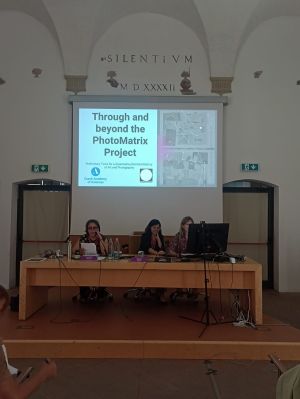
2025-09-11
#conference talk
This talk considers how the tools developed within the PhotoMatrix project can support and expand feminist approaches to art- and photo-historical research. Drawing on a corpus of over 400 periodicals from Czechoslovakia, France and Germany, the project explores the narratives of art and photography in the first half of the 20th century through the lens of photomechanical reproductions of art. In this talk, we argue that photomechanical sources have the potential to expand the canon, in particular in terms of forgotten authors, including women and minorities. On the one hand, close readings of individual cases, such as Trude Fleischmann and Aenne Biermann, demonstrate how photomechanical reproduction preserved otherwise lost works, reshaped meaning through editorial mediation, and strengthened systemic gendered marginalizations. On the other hand, large-scale analysis through computer vision, caption detection, and database structuring allow patterns of visibility and exclusion to be measured, through calculations of the frequency and distribution of women artists and photographers represented in early 20th-century periodicals.
Conference talk by Camilla Balbi & Fedora Parkmann, “Through and beyond the PhotoMatrix Project: Preliminary Tools for a Quantitative Feminist History of Art and Photography”, Photography and Feminist Aesthetics. Italian and Transnational Perspectives, Bologna, University of Bologna, 11–13 September 2025.
Assembling the Nude: František Drtikol’s Photographs in Interwar Magazines(by Fedora Parkmann)

2025-09-03
#conference talk
This paper focuses on one of the most marketable genres of artistic photography – the female nude – and examines the network of actors involved in publishing these images in interwar art magazines. An immensely popular nude photographer in the interwar period, the Czech František Drtikol constitutes an ideal subject for such an investigation. His nudes were widely disseminated in magazines throughout Europe and the US – this paper considers Germany, France, and the US. Unpublished documents from Drtikol’s archive indicate that this aspect of his career resulted from a collective production process in which the boundaries between his contribution and that of his collaborators were often blurred. Drtikol worked closely with a press agent and liaised with publishers, art critics, printers, photograveurs, and customs officers to facilitate the dissemination of his work, suggesting that photomechanically-printed nude photographs are complex entities, assembled from the contribution of multiple actors to achieve their final form and meaning. The politics of visibility that shaped the presence of nude photography on the magazine page should, therefore, be understood as the product of a “decisive network” of actors, whose collaboration was essential in determining the printed nude’s aesthetic value, its position in the hierarchy of artistic genres, and its acceptability within societal norms.
Conference talk by Fedora Parkmann, “Assembling the Nude: František Drtikol’s Photographs in Interwar Magazines”, 13th ESPRit Conference, Periodicals as Cultural Assemblages, Málaga, Universidad de Málaga, 3–5 September 2025.
(Re)producing entartete Kunst: i network dell’esilio e l’agitazione politico-fotografica degli artisti tedeschi in Europa centrale(by Camilla Balbi)
2025-05-12
#conference talk
If nomadisms inevitably operate outside the canon (Dogramaci, 2019), exile appears instead capable of generating transnational counter-canons, crossing media, contexts, and authors. The exile, living as an “eternal half-another” (Benhabib, 2018), embodies a “contrapuntal” vision of history (Said, 1984)—diffuse yet coherent—which integrates homeland, host nation, and the transnational networks of the diaspora. From this perspective, photography—together with photomechanical reproductions and the infrastructures that enable their circulation—assumes a crucial role: as a document for disseminating artistic experiences between homeland and exile; as a platform for a visual counterculture of opposition; as a tool for critique and for the manipulation of the imaginary.
The proposed paper examines the impact of Nazi cultural policy on German exile networks in Prague (1934–1938), focusing on the use of photography and photomechanical remediation in the work of exiled artists such as John Heartfield and in German exile journals such as Simplicus and AIZ. Beginning with the National Socialist attack on the 1934 Prague Exhibition of Satirical Art, the paper analyses how the photographic image—once it becomes a network—helped shape artistic resistance to National Socialism and a distinct imaginary of exile.
Conference talk by Camilla Balbi, “(Re)producing entartete Kunst: i network dell’esilio e l’agitazione politico-fotografica degli artisti tedeschi in Europa centrale”, Cultura fotografica. L’immagine ottica come testimone e agente politico-sociale, ISREC University of Parma, Parma, Italy, 12–13 May 2025.
Absenting Copies: Josef Sudek’s Unpublished Photographic Book Project(by Hana Buddeus and Katarína Mašterová)
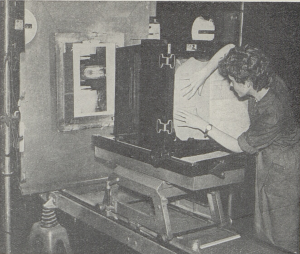
2025-04-10
#conference talk
In the history of photography, it is now widely recognized that the concept of the original is contingent on specific factors and can shift over time. Scholars have increasingly explored themes such as ubiquity (Blaschke), and dissemination (Batchen). Photographs are often viewed as “unfettered” entities (Henning), existing “always there, but not there” (Batchen). Boris Groys argues that digitalization has radically transformed the relationship between an original and a copy, suggesting to “re-territorialize a copy.” But what happens when the intended copy never materializes, and only the original vintage prints remain?
Our case study stems from these questions to address a rediscovered collection of 260 photographs by Josef Sudek. These images were created for a book documenting Prague’s St. Vitus Cathedral. The project began in the early 1940s during the Nazi occupation, when patriotic imagery of historical monuments subtly served as a form of resistance. However, the shifting political climate after the war resulted in the book’s publication being canceled. Although the preserved collection of prints showcases Sudek’s aesthetics, its intended purpose—as a widely disseminated book illustrated with photomechanical reproductions—was never realized. This example shows how the absence of the copies alters the photographs’ agency and questions their status as originals.
Conference talk by Hana Buddeus and Katarína Mašterová, “Absenting Copies: Josef Sudek’s Unpublished Photographic Book Project”, Association for Art History Annual Conference, University of York, 9–11 April 2025.
(Re)producing Entartete Kunst: Exiles Networks and Political Agitation from Prague to Paris(by Camilla Balbi)

2025-03-27
#conference talk
In the proposed talk, I will examine the impact of National Socialist art policy on German exile networks in Czechoslovakia, and its resonance in Parisian émigré circles. In this sense, I will discuss how exiled artists such as John Heartfield and Prague-based exile journals such as Simplicus and AIZ used the reactions provoked by their politically charged art to familiarise local audiences with the theme of artistic resistance to National Socialism, even before the term “degenerate art” entered public discourse. A resistance that paved the way for a real debate on “degenerate art” in the Czech environment in 1937 with the exhibitions on German Expressionism (Němečtí expresionisté) and the “new works of the Manes Association” (Dnešní Mánes). Finally, the reception of these exile experiences in Parisian émigré circles is examined, focusing first on their presence in the Pariser Tageblatt and later in Freie Kunst und Literatur. This analysis sheds light on the mediating role of intellectual agitators such as Paul Westheim, the contributions of exiled artists from Prague and their rhetorical strategies in the Paris counter-exhibitions of 1938, and in the satirical illustrations published in Freie Kunst und Literatur. Particular attention will be paid to the media dimension of this exchange, examining how the dissemination of “poor” images (Steyerl, 2009) — including photography, mechanical photoreproductions, photomontages, drawings and facsimiles — played a central role in shaping the exile's response to Nazi cultural policies and the concept of “degenerate art”.
Conference talk by Camilla Balbi, "(Re)producing Entartete Kunst: Exiles Networks and Political Agitation from Prague to Paris", L’art « dégénéré ». Une Histoire Croisée France/Allemagne, INHA Musée Picasso, Paris, 27–28 March 2025.
Middle Eastern clichés. Hugo Hermann and the Palästina Bilder Korrespondenz(by Camilla Balbi)
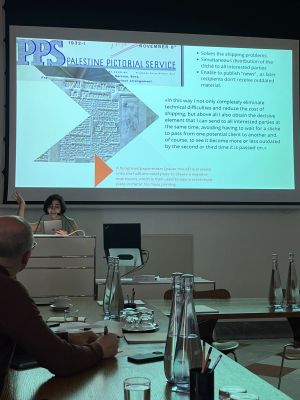
2025-03-17
#conference talk
This study focuses on the hitherto unexplored case of the Clichézentrale, which was founded by Hugo Herrmann in Brno in 1929. Drawing on archival material from the Zionist Central Archive in Jerusalem and the Archive of the Jewish Museum in Prague, my proposal uncovers the central role that the Clichézentrale played in the construction of a Zionist visual sphere in the interwar period. Remarkably, most of the images of the British Mandate that appeared in prominent Jewish publications in Germany, France, Italy, Switzerland, the Czech Republic, Poland, Belarus and even China came from the clichés of this institution, providing an emblematic example of transnational circulation and dissemination. In this context, a network that reached from the periphery (Jerusalem) to the outskirts (Brno) of Western culture informed a network that included the great centres of European culture. A visual narrative produced by emigrants (like many of the photographers who made the images) to promote emigration, redefining geographies, borders and identities in between. While the photographs that were eventually published in the Jewish press depicted a serene and meticulously codified Middle East, the history of the production and dissemination of their clichés reveals a web of entangled political, cultural, ethno-religious and socio-economic structures. In order to uncover the history of the Clichézentrale, it is necessary to engage in a multifaceted investigation of material and intellectual history. According to what criteria were the clichés commissioned by photographers living under the British Mandate? What were their esthetic and technical requirements? How did the economic and legal framework of this market function? What identities and subjectivities did they exclude, and how? Ultimately, this archeology of a forgotten visual history also represents a theoretical attempt to tie the construction of an iconosphere to its material, historical, and geographical roots.
Conference talk by Camilla Balbi, "Middle Eastern clichés. Hugo Hermann and the Palästina Bilder Korrespondenz", Centers and Peripheries: Photography’s Geography Lessons, Bibliotheca Hertziana – Max Planck Institute for Art History, Rome, 17–21 March 2025.
The Use of AI in the PhotoMatrix Project(by Viktorie Vítů)
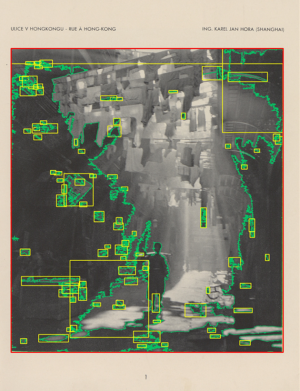
i
Image localization on the page of the magazine.
2024-11-08
#conference talk
Digital art history has faced criticism for its reliance on canonical datasets (Bishop, 2018) and traditional art historical methodologies (Wasiliewski, 2023). The PhotoMatrix project addresses these issues by focusing on a relatively new source in art history - photomechanical reproductions of art – instead of the artworks themselves and seeks ways to unlock their potential by using computational tools. Concentrating on Czech, French, German, and Russian art magazines from the first half of the twentieth century, we pose the question: How does our understanding of art history shift when viewed through the lens of reproductions published in contemporary magazines? Our approach involves not only a statistical analysis of the art featured in these periodicals but also an examination of how specific artworks were presented and disseminated across different countries through these reproductions.
In addressing these questions, it is necessary to consider the various "layers" of photomechanical reproduction in a digitized magazine. Such a reproduction results from multiple "translations": first, the artwork was photographed; then, the photograph was transferred to a printing matrix; next, the image was printed; and finally, the periodical was digitized. We have incorporated these different layers into our database of photomechanical reproductions. In this paper, we present our approach to developing the database and digital tools (image extraction, image matching, caption analysis) and explain what we hope to achieve from these tools while also focusing on their blind spots and weaknesses. Our challenge is integrating these quantitative methods with more traditional qualitative research to fully reveal the potential of photomechanical art reproductions, both as valuable sources for art history and as subjects deserving of their own study.
Conference talk by Viktorie Vítů, “The Use of AI in the PhotoMatrix Project”, Humanitní a společenské vědy z pohledu Digital Humanities II / Humanities and Social Sciences from the Perspective of Digital Humanities II., Palacký University Olomouc, Czech Republic, 8–9 November 2024.
Beautiful, Exquisite Gift. Calendars by DP (1931–1944)(by Hana Buddeus)
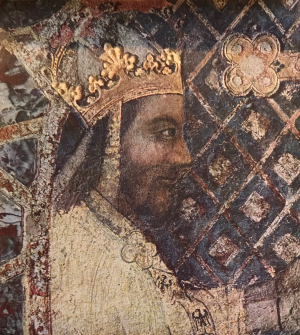
i
Three-color reproduction featured in the DP Calendar for 1940 (Karel IV., wall painting at Karlštejn Castle, ca. 1365. Photograph by Jan Štenc)
2024-11-07
#conference talk
Founded in Prague in 1922, the Družstevní práce (DP) cooperative sought to democratize culture by offering well-designed and affordable publications. Graphic designer Ladislav Sutnar shaped DP’s distinctive visual identity and imbued it with a modern style. This study focuses on DP's annual desk calendars, produced from 1931 to 1944 to address the limited availability of Czech art reproductions. These calendars sparked cultural debate, particularly regarding their role in promoting contemporary art to DP members. Practical yet culturally significant, the calendars became popular gifts, contributing to DP’s role in distributing art to a broad audience. This paper, inspired by material culture studies, examines the calendars as cultural artifacts, focusing on their production and the role of photomechanical prints in shaping art distribution and cultural identity.
Conference talk by Hana Buddeus, “Beautiful, Exquisite Gift. Calendars by DP (1931-1944)”, Art History As a Gift conference, Berlin, 7-9 November 2024.
The Emancipatory Power of Reproductions: Neglected Narratives of Avant-Garde Photography(by Camilla Balbi and Hana Buddeus)

2024-10-17
#conference talk
In ReD, a leading illustrated magazine of the Prague interwar avant-garde, various visual materials are skillfully combined. Aerial photography, movie stills, typography and photomontages are integrated through the vision of Karel Teige, the editor of the magazine, which was published by the Devětsil group from 1927 to 1931. This paper aims to reveal the emancipatory potential of an approach rooted in the materiality of photomechanical reproductions by uncovering two different stories that converge on a double-sided page of the 1929 ReD magazine. What narratives underlie an X-ray photograph of a fish and a night photograph of fireworks? How were these images acquired for the magazine and why? By telling the specific story of these pictures, we aim to illuminate and “liberate” subjectivities, actors, and networks that have been previously neglected by art historical narratives. As a result, we see a medical image not as an anonymous picture appropriated at some point by László Moholy-Nagy, but rather as an X-ray photograph produced in a laboratory for the scientific education of women in Germany. And, tracing the path of the fireworks image reveals the significant presence of Aenne Biermann, a German Jewish photographer, in Czech periodicals of the late 1920s, a regular contributor who has been overlooked until now.
Conference talk by Camilla Balbi and Hana Buddeus, “The Emancipatory Power of Reproductions: Neglected Narratives of Avant-Garde Photography”, ASEEES (Association for Slavic, East European, and Eurasian Studies) Virtual Convention, Boston, USA – online participation, 17–18 October 2024.
Photomechanical Reproductions of Works of Art in Digital Perspective: Potential and Challenges(By Fedora Parkmann and Viktorie Vítů)
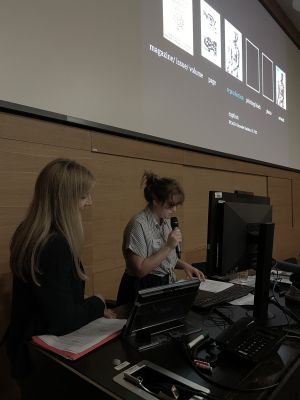
2024-09-14
#conference talk
This talk was presented in the “Digital Art History” section of the Congress. It aimed to assess what digital and quantitative approaches can bring to art history. Digital art history has been criticized for its use of canonical datasets (Bishop, 2018) or for its over-reliance on traditional art historical approaches (Wasiliewska, 2023). To address these issues, the Photomatrix project focuses on a relatively new source for art history – photomechanical reproductions of art – rather than artworks, and seeks ways to unlock their potential through the use of computational tools. Focusing on Czech, French, German and Russian art magazines of the first half of the twentieth century, the project asks what new narratives of art emerge when we look at this period through the lens of reproductions printed in contemporary art magazines. This involves not only statistically determining what art appeared in these periodicals, but also examining how and by whom art was presented and circulated across different countries through photomechanical reproductions. Such a perspective can contribute to a better understanding of how the art historical canon is constructed. In this paper, we discussed our approach to developing the database and the digital tools we use (image extraction, image matching, caption analysis), explaining how they can change our view of the art historical canon, but also focusing on their blind spots and weaknesses.
Conference talk, Fedora Parkmann & Viktorie Vítů, Fotomechanické reprodukce uměleckých děl v digitální perspektivě: možnosti a výzvy [Photomechanical Reproductions of Works of Art in Digital Perspective: Potential and Challenges]. Presented at the 8th Congress of the Czech Association of Art Historians, Brno, 12-14 September 2024.
Exhibitions in Two Dimensions: Pictorial Reports in the Period Press for the General Public(by Katarína Mašterová)
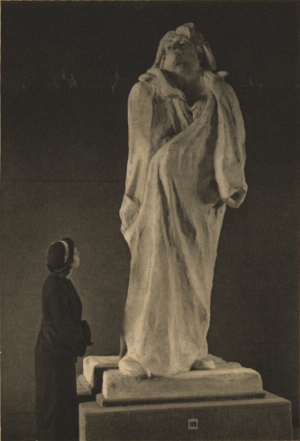
i
View of the exhibition Modern French Sculpture in Belvedere, Prague, 1935. Reproduction from the magazine Pestrý týden, 15 June 1935. Photo: Tibor Honty.
2024-09-13
#conference talk
What strategies of visual representation were used by the illustrated press in the first half of the 20th century in their coverage of exhibitions? What role did pictorial documentation of exhibitions play in the mass media and art press, and what message did it convey to the reader? Did it have a marketing effect and attract larger audience? In the case of post-exhibition coverage, what were the methods of pictorial documentation of the exhibition, and what objectives did they pursue? In this paper, I will focus on the photomechanical reproduction of exhibition photographs in the contemporary press of the interwar period and compare them with the current situation of reporting on exhibitions in the form of pictorial documentation, which often becomes a substitute for physical exhibition visit (from the Martin Fryč phenomenon to the professionalization of social media of exhibition institutions). Among the key historical examples, I will include photographs of sculptures, which offer more dynamic possibilities for the photographer's work. One such example is the exhibition of Modern French Sculpture at the Belvedere in 1935, which was carried out with significant cultural and political overtones and reported in most illustrated media such as Pestrý týden, Letem světem, Světozor or Volné směry. The paper will focus on the exploration of the methods of conveying the artistic value of the exhibited works, as well as on the possible forms of manipulation of readers by the type and form of pictorial representation, the relationship between image and text, or the recycling of images by different media.
Conference talk by Katarína Mašterová, "Výstavy ve dvou rozměrech: Obrazové reportáže pro širší veřejnost [Exhibitions in Two Dimensions: Pictorial Reports in the Period Press for the General Public]", 8th Congress of the Czech Association of Art Historians – The Endings (and Beginnings) of Times, Masaryk University, Brno, Czech Republic, 12–14 September 2024.
Finding Röntgen: Medical X-Ray Photographs in Avant-Garde Journals, a Transnational Journey(by Camilla Balbi)
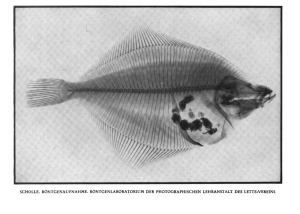
2024-09-11
#conference talk
The discovery of X-rays in 1895 marked a turning point in the communication of scientific breakthroughs, as highlighted by their announcement in the Vienna Presse. This event signaled the rise of technical images in media culture, stepping beyond medical and scientific contexts. This presentation examines X-ray images not as media but as photomechanically mediated objects, focusing on their role in periodical culture and their transformative impact on modernism and the avant-garde. It traces the journey of a single X-ray photograph from a Berlin laboratory training female scientists to medical publications in Vienna, art journals in Berlin, and finally the Prague avant-garde magazine ReD in 1928. Misattributed to Moholy-Nagy in the 1930s, this case study demonstrates how periodical studies can illuminate the interplay between scientific images and art history, revealing marginalized authorships, particularly those of women, and offering new insights into transnational migrations and attributions in visual culture.
Conference talk by Camilla Balbi, “Finding Röntgen: Medical X-Ray Photographs in Avant-Garde Journals, a Transnational Journey”, presented at Periodicals: S.T.E.A.M. Ahead!, XII International Conference European Society for Periodical Research (ESPRit), Urbino, Italy, 11–13 September 2024.
A neue Shehen? Germaine Krull and Trude Fleischmann Aktfotografie(by Camilla Balbi)

2024-06-19
#conference talk
The paper delves into the pioneering work of Germaine Krull (1908) and Trude Fleischmann (1895), two Mitteleuropean women who defied societal norms as secular, middle-class, emancipated, and openly queer women working in photography. Their contribution to European photographic Modernism has often been overlooked, marginalized by a historiography that has long neglected female experiences scarred by history and exile. The focus of this study is a reexamination of the early nude photographic portraits they both realized between 1924 and 1925. Through the recent lenses of queer and visual studies, I aim to situate the gaze of these young photographers within the broader cultural contexts of the era. This entails placing their work in dialogue with influential currents such as the neue Sehen and the freikörperkultur, while also scrutinizing its reception within the official medical and media spheres of the time. Ultimately, this article uncovers how the queer gaze both decentered and redefined representations of the female nude during the dynamic – and dramatically ephemeral – cultural landscape of the 1920s.
Conference paper by Camilla Balbi, “A neue Shehen? Germaine Krull and Trude Fleischmann Aktfotografie”, Genere e Storia Oltre i Confini, IX Congresso della Società Italiana delle Storiche, Università degli Studi di Palermo, Palermo, 19–22 June 2024.
The article from this paper entitled “Photomechanical Nachleben and the Queer Art of Failure. The Aktfotografie of Germaine Krull and Trude Fleischmann” was awarded the runner-up Prize in the W+IGS (Women in German Studies) 2024 Essay Prize and will be published soon.
Visual Message: Photography as a Mode of Interpretation in the Reproductions of the Magazine Výtvarné umění (Fine Art)(by Katarína Mašterová)
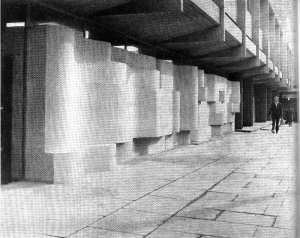
i
Sculptural wall by Stanislav Kolíbal for the building of the former Czechoslovak Embassy in London, in collaboration with architects J. Šrámek, J. Bočan and K. Štěpánský. Reproduced in Výtvarné umění (Fine Art) 19, 1969, no. 9-10, p. 448. Photographer unknown.
2024-06-07
#conference talk
Since its emergence before the mid-nineteenth century, photography has played a crucial role in establishing scientific disciplines and preserving cultural heritage. It has served as a means of recording and preserving memory, a tool for connoisseurship, and a vehicle for disseminating visual messages. It has become a paratext to the discourse of art history (Hamill - Luke 2017). In his reflections on the interpretive potential of photography in relation to sculpture, Heinrich Wölfflin distinguished between a correct view—aligned with the artist's intention—and a distorted or misleading one (Wölfflin 1896, 1897, 1915). As modern art evolved, new generations of photographers and artists began to use photography to capture the essence of artworks, intentionally providing their own visual interpretations. However, it is not solely the photograph itself or the individuals involved—the photographer, the artist of the depicted work, or the commissioner of the image—that influence our understanding of photography; the context in which it is used also plays a significant role. This paper focuses on photographs of sculpture in architecture or public space as featured in the 1960s magazine Výtvarné umění (Fine Art). What pictorial strategies did this magazine follow and what identity of sculptural works did it reveal in its reproductions? Have there been changes over the decades? What visual canon was applied here?
Conference talk by Katarína Mašterová, "Vizuální sdělení. Fotografie jako způsob interpretace v reprodukcích časopisu Výtvarné umění" [Visual Message: Photography as a Mode of Interpretation in the Reproductions of the Magazine Výtvarné umění (Fine Art)], Od architektury k interpretaci (Média architektury II), Department of Art History of the Masaryk University and Methodological Centre for Modern Architecture, Brno, Czech Republic, 7–8 June 2024.
From the Margins: Jewish Women Photographers in, and after, Weimar(by Camilla Balbi)

2024-05-30
#invited symposium talk
The presentation examines the emergence of female and Jewish photographic culture during the Weimar Republic and its diasporic trajectory post-1933. Avoiding specific case studies, it provides a broader narrative that critically illuminates the decade’s cultural landscape. Figures like Lucia Moholy worked within a milieu marked by intersections of ethnicity, class, gender, and sexual orientation, shaping photography as a "gendered" practice influenced by material, institutional, and socio-historical factors. The post-1933 exile subjected this corpus to hybridization and transnationality, creating new paradigms worthy of systematic study. This exile—both physical and historiographical—marginalized these women due to racial and gendered politics, pushing their contributions to the periphery. Recovering their networks, aesthetics, and movements reveals untapped hermeneutical paths in Weimar photography history, intersecting with material history, exile studies, and decolonial studies, fundamentally transforming the photographic canon.
Invited lecture at the symposium Multiple Frames for Lucia Moholy, Goethe-Institut and Kunsthalle, Prague, 30 May 2024.
Printer as Publisher. The Photomechanical Reproductions of V. Neubert & Sons across Print Media(by Fedora Parkmann and Viktorie Vítů)
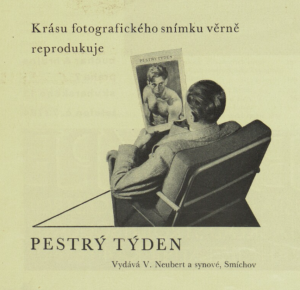
2024-04-30
#conference talk
In interwar Czechoslovakia, the printing and publishing concern V. Neubert & Sons emerged as a prominent cultural actor encompassing both specialized and general print media. The company printed and/or edited periodicals, books, maps, guidebooks, company catalogues, and advertising brochures. To showcase its commercial offer and the superior quality of its rotogravure printing process, Neubert also published the popular illustrated magazine Pestrý týden (Colorful Week) from 1926 to 1945.
The visual content of mass-market periodicals such as Pestrý týden has been approached from the perspective of their graphic design (Frizot & De Veigy, 2009), their role in the popularization of art (Cinelli et al., 2013) or their impact on mass visual culture (Beegan, 2008), but less often through the prism of the printer. This paper places the illustrations in Pestrý týden in the context of Neubert’s broader production of ‘ink and paper’ materials. The various affiliations that occur within this network of photomechanical reproductions reveal that Neubert’s activities determined part of the visual content of the magazine. These transmedial circulations of images were driven by various strategies – commercial interests, educational aims, and popularization of Czech art and photography –, all of which are linked to the nationalist sentiment that fueled Neubert’s enterprise from the outset, and his belief that beautifully printed photographs were Czechoslovakia’s best calling card.
Conference talk, Fedora Parkmann & Viktorie Vítů, "Printer as publisher. The photomechanical reproductions of V. Neubert & Sons across print media." Presented at Networks and Visual Seriality in Mass-Market Print Culture, Brussels & Leuven, KBR & KU Leuven, 29-30 April 2024.
Rachel Wischnitzer and the Photomechanical Foundations of Jewish Art History(by Camilla Balbi)
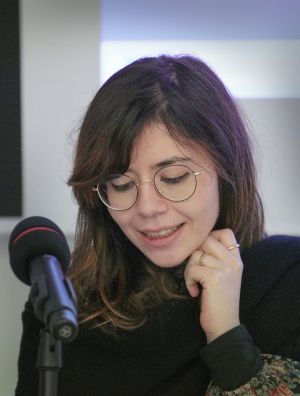
2023-12-05
#conference talk
From 1921 to 1924, Berlin became one of the epicenters of the so-called “Weimar Jewish Renaissance” (Brenner, 1996): a golden age of cultural, artistic, and literary activities that for the first time sought to address a specifically Jewish audience and create a Jewish public sphere. Flooded with refugee Jewish intellectuals from Eastern Europe, the city became an ideal platform for the rise of Jewish books, whose publication and dissemination was facilitated by low-cost printing and postage during the years of hyperinflation. Printed in Germany, these books were exported around the world.
For intellectuals interested in art history, this was the first opportunity to present a significant amount of Jewish visual material to the public. The material, often locked away in archives or located in remote regions of the Middle East or Eastern Europe, had previously received little attention as an object of study. The most significant attempt to include it in the Western art-historical and theoretical debate was made by Rachel Wischnitzer, a Russian-born art historian, in her bilingual (Hebrew and Yiddish) magazines Rimon/Milgroym, published in Berlin between 1922 and 1924. These magazines are considered ”the most beautiful and interesting journals of Jewish art that ever appeared” (Fuks, 1988).
In the proposed paper, I will reconstruct the material history of the magazines using archival material from the Leo Baeck Institute. This involves investigating the production, reception, and afterlife of the photomechanical reproductions they contain. The reproductions resulted from a complex interaction of academic scholarship and avant-garde research (noteworthy is El Lissitzky’s engagement in producing some of the pictures of the Mogilev Synagogue) which played a role in preserving what was, in some cases, the only visual evidence of artworks that perished in the war, thus bringing to light the construction of the first Jewish transnational visual culture.
Art within Reach: Photomechal Reproductions of Work of Art from Print to Digital, 5–6 December 2023, Institute of Art History, Czech Academy of Sciences, Prague
The Production of Photomechanical Reproductions of Art: Consensual Exchange, Stolen Glances and Embellished Reality(by Hana Buddeus)

2023-12-05
#conference talk
While the subject of photographic reproductions of artworks has recently garnered increasing attention, a comprehensive understanding of their complex production and distribution remains far from complete. In the wake of the material turn, many photography historians have shifted their focus from aesthetics to the very physical aspects of the medium. This newfound fascination with the material essence is evident in the heightened scrutiny of the tactile attributes of its diverse manifestations, including printed photomechanical reproductions.
Based on research within Czech archives, this paper undertakes an examination of the diverse material embodiments of photography interwoven with the complex process of producing reproductions for art magazines. It delves into the methods embraced by editors of art and art history journals published in the first half of the 20th century (Volné směry, Život, Umění) that span from commissioning original shoots and buying pictures by renowned photographers and photo agencies to exchanging photographs on both national and international level, and even rephotographing existing reproductions sourced from foreign magazines. The archival findings vividly showcase how the term “photography” is rich in meaning, materializing in a variety of forms (prints, glass and film plates, and process blocks) dictated by the chosen printing process and the desired outcome.
Moreover, it reveals how the post-production phase, involving nuances such as background adjustments, cropping, size modulation, and contrast refinement, played an integral role in the journey that culminated in the creation of seemingly "transparent" images. Shedding light on these conventional yet invisible tools promises to unravel the intricate dynamics of decision-making, communication modalities, and exchange strategies that underlie the process of producing the photomechanical reproductions of artworks.
Art within Reach: Photomechal Reproductions of Work of Art from Print to Digital, 5–6 December 2023, Institute of Art History, Czech Academy of Sciences, Prague
Behind the Photographs: Copyright and Photomechanical Reproductions of Art, a Burning Issue in Europe at the Turn of the 20th Century(by Marta Binazzi)
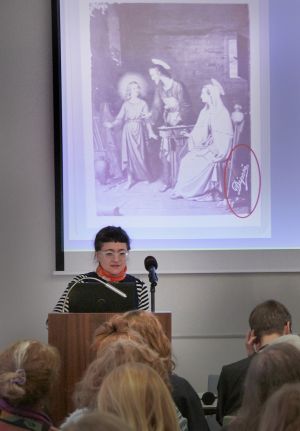
2023-12-05
#conference talk
In the 1890s, owners of photographic companies based in Europe formed unions or associations specifically devoted to the protection of photographic copyright. Their main objective was to ensure that photographers were protected against unauthorized reproduction of their work by publishers and the illustrated press. The industrialization of photomechanical processes, and in particular the introduction of halftone printing, greatly expanded the possibilities of photographic reproduction. Images could now be disseminated through books, journals, but also postcards, various objects and advertisements, which circulated widely, becoming transnational products. In this new international scenario, with non-existent or unclear laws protecting photographs, publishers could reproduce them using photomechanical processes without paying any reproduction rights. Moreover, reproductions of artworks raised problems of ownership and copyright that other photographs did not, fostering intense debates.
This paper analyzes the institution of these unions while also focusing on selected lawsuits between the 1890s and the 1920s that dealt with the unlawful reproduction of photographs of artworks. By examining these sources, the paper exposes the overlooked processes of production of photomechanical illustrations of art and the commercial mechanisms associated with them. In fact, there were laws regulating the financial relationships between photographic companies, publishers of magazines and postcards, photographers, agents, commercial libraries, artists whose work was photographically reproduced or galleries owning the rights over artworks, and other actors involved in the system. Although neglected by historiographies that privilege author-oriented narratives, the actors behind the production and circulation of photographs, such as publishers, photo agencies, commercial picture suppliers, and printing companies, played a key role. This paper aims to show their relevance.
Art within Reach: Photomechal Reproductions of Work of Art from Print to Digital, 5–6 December 2023, Institute of Art History, Czech Academy of Sciences, Prague
Artists as Influencers? Emil Filla and Josef Wagner, Prominent Figures of Czech Modernism, as Editors of the Art Magazine Volné Směry(by Katarína Mašterová and Viktorie Vítů)
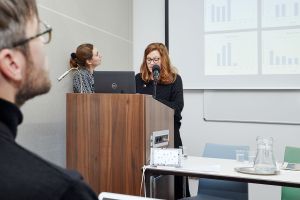
2023-12-05
#conference talk
The interwar era of the Czechoslovak Republic saw a flourishing art scene influenced by European modernism, notably from Paris. Artistic exchange and shared reproductions played a crucial role, facilitated by magazines such as Cahiers d’Art and Minotaure. The Mánes Association of Fine Artists (Spolek výtvarných umelců Mánes), founded by young Czech artists in 1887, acted as a hub for embracing and producing modern art trends, aiming to introduce foreign influences. Their primary activities included organizing exhibitions and publishing a prominent monthly art magazine, Volné směry (Free Tendencies, 1896–1949), which offered numerous large-format reproductions as one of its distinctive features.
Volné směry had editors and an editorial board consisting of engaged members of the Association. The painter Emil Filla and the sculptor Josef Wagner were the last two regular editors, Filla serving from 1933–1938 and Wagner from 1939–1944. Both were active and well-received artists, as well as essayists and art archivists. They were knowledgeable about both the local and international art scenes, with equal insight into traditional art and contemporary trends. After the war, they were active leaders, organizers, and respected university teachers. Both regularly commissioned photographs of their work from Josef Sudek, who was an associate photographer for the magazine. In addition, both artists collected reproductions, although Filla’s archive was more extensive (Winter ed. 2010).
Did Filla and Wagner reflect their artistic tastes during their respective editorial tenures? How did they shape the visual strategies of Volné směry? What was the magazine’s transnational reach during this period, and how did it influence the public? Can we think of Volné směry as a platform for disseminating progressive tendencies to the general public – mainly through the power of images – in order to shape a modern citizen? How did the magazine’s objectives shift during the war? To address these questions, we will draw upon archival materials from the Mánes Association (including documents related to Volné směry) and the personal archives of the artists. Additionally, distant viewing methods will provide a more comprehensive understanding of the magazine's orientation, choices, and reach. Statistical analysis will help us understand the evolution of reproduction composition in the interwar and wartime periods, with a special focus on author’s nationalities, artwork’s dates of origin, and reproduction sizes.
Art within Reach: Photomechal Reproductions of Work of Art from Print to Digital, 5–6 December 2023, Institute of Art History, Czech Academy of Sciences, Prague
Distant Viewing: Photomechanical Reproductions(by Viktorie Vítů and Fedora Parkmann)
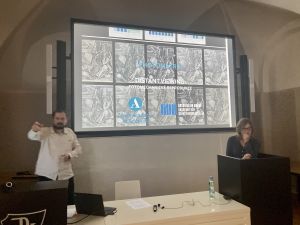
2023–11–09
#conference talk
In this talk, we introduced the methodology of the PhotoMatrix project and the first results of the statistical processing of the collected data. In the wake of distant reading computing tools, distant viewing opens a range of possibilities for scholars in art history, photography and visual studies. Our project applies methods of distant viewing to a specific type of image, the photomechanical reproduction of art, and aims to address the complexity of its multiple layers: a photograph of the artwork is taken, which is transferred to a printing matrix, which is then printed, together with a caption, and the periodical is digitized. The statistical analysis focused on captions of images published in the magazine Volné Směry and confirmed the connection between the editor of the magazine and the type of artworks published.
Presentation within the conference Humanitní a společenské vědy perspektivou Digital Humanities [Humanities and Social Sciences from the Perspective of Digital Humanities], Univerzita Palackého, Olomouc, Czech Republic, 9 November 2023.
V. V. Štech and Photography(by Hana Buddeus)

2023-10-20
#conference talk
How did Václav Vilém Štech contemplate photography, how did he write about it, and how did he handle reproductions in his publications? In this contribution, I build upon my previous research, focusing particularly on Štech's publishing activities in the 1930s, in which he often deliberately utilized photographic reproductions to support his arguments and to update old art for the contemporary audience. Based on an examination of reproductions in his other, earlier, and later publications, as well as images from Štech's estate, I subject a broad spectrum of photographs he encountered to a critical reading. These range from studio portraits and travel snapshots to photographs used for reproductions. His collaboration with the photographer Josef Ehm demonstrates how they worked with the visual accompaniment in joint publications, using it as a means of communication, allowing, for instance, the juxtaposition of the whole and the detail or the visual confrontation of different artistic styles.
Conference talk by Hana Buddeus, "V. V. Štech a fotografie". Presentation within the conference Historik a teoretik umění V. V. Štech [Historian and theorist of art V. V. Štech], UMPRUM, Praha, Czech Republic, 20 October 2023.
Vilém Santholzer between Science and the Avant-Garde(by Viktorie Vítů)

2023-02-22
#invited lecture
In the 1920s, Vilém Santholzer published several dozen articles on the beauty of machines, a text on the aesthetic power and authenticity of scientific photography, and even several of his own photographs of radioactive radiation in Czech avant-garde periodicals. The lecture will focus on the connection of this renowned radiologist, medical physicist, and tireless popularizer to Central European avant-garde circles, asking in particular about Santholzer's idea of beauty rooted in purpose and authenticity. It will thus show why he believed that modern airplane sculpture should surpass ancient sculpture and that the beauty of scientific photography should triumph over artistic photography.
Invited academic lecture by Viktorie Vítů, Collegium Historiae Artium lecture series, Institute of Art History of the Czech Academy of Sciences, Prague, 22 February 2023.
The Matrix of Photomechanical Reproductionsof Art: Research Project Presentation(by Hana Buddeus and Fedora Parkmann)
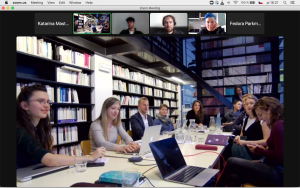
2022-09-23
#project presentation
An invited talk within the Research Seminar of the CEFRES by Hana Buddeus and Fedora Parkmann on 23 September 2022. The presenters introduced the PhotoMatrix project, which examines the rise and spread of photo-reproductions in Czech, French, German, and Russian art journals from 1900 to 1950. By combining digital humanities and archival research, the project aims to expand our historical knowledge from the local to the transnational, and from the empirical to big data, thus opening up new insights into the use of remote access to art in the digital age. This talk traced the various steps that led from the conception of the project to the submission of a proposal, and discussed the project’s methodology and goals.
Video presentation of the prize awarded to Fedora Parkmann
2023-01-02
#video profile
In 2022, the Czech Academy of Sciences represented by its President, Eva Zažímalová awarded the Lumina Quaeruntur Prize to six talented scholars, including the French & Czech researcher Dr. Fedora Parkmann from the Institute of Art History. The award has enabled Dr. Parkmann to establish and finance our research project for the next five years. On this occasion, a video presentation was made by the Czech Academy of Sciences. (In Czech only).
Visual Research
Visual Structure of Magazines(by Adéla Svobodová)
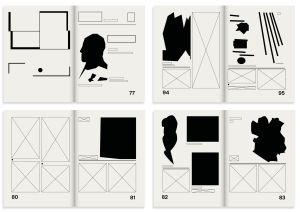
2025-23-01
#visual research
As a graphic designer, I focus on art magazines from 1900 to 1950, with an emphasis on their formal analysis. My practical experience in creating magazines and books – albeit a century later – enables me to closely examine the structure of these publications from the perspective of a graphic designer who actively engages with the relationship between text and image in printed media.
I analyze art magazines from 1900 to 1950 in terms of composition and the interaction between text and image. I pay particular attention to the formal use of accompanying elements, such as captions and annotations. I explore the relationships between these elements through visual language, translating individual typescripts into geometric structures, in which text and photographic reproductions lose their original function and become matter displayed on the page.
This schematic structure helps to reveal how the magazines were designed. By comparing the layouts of individual art magazines and examining their typesetting methods, we can determine where in the process of their creation the emphasis was placed on a well-organized system and where the typesetting was guided by more intuitive principles. Much like art, graphic design in the early twentieth century was a balancing act between traditional typography and modernist experimentation, a dynamic that is reflected in the graphic design of illustrated magazines.